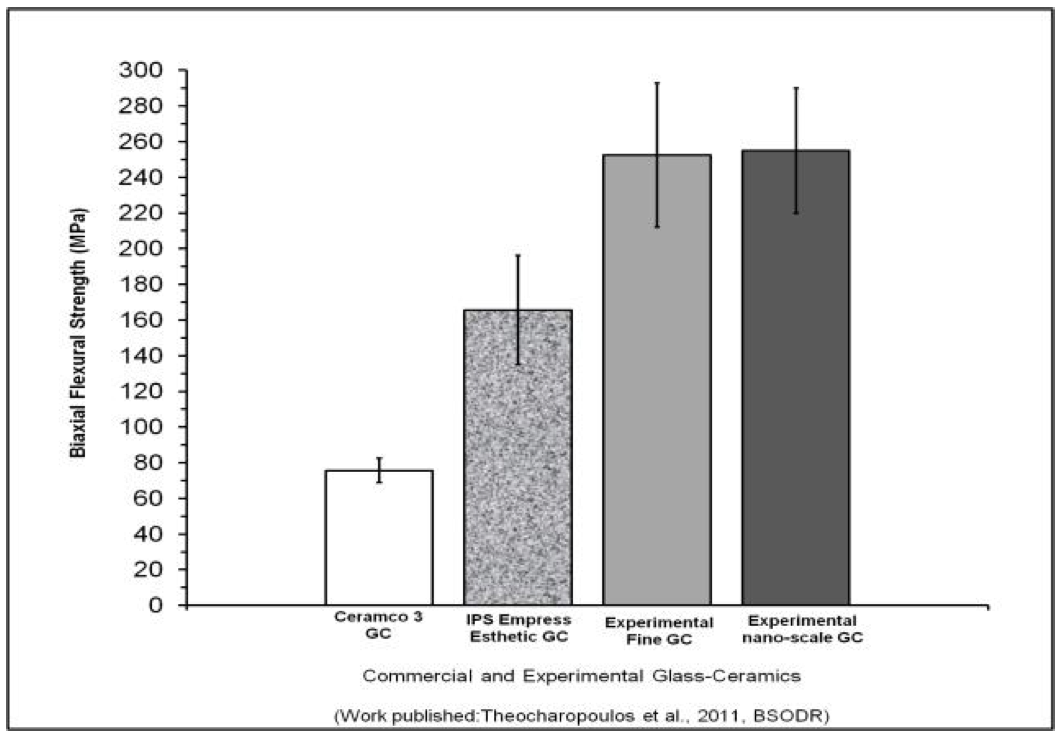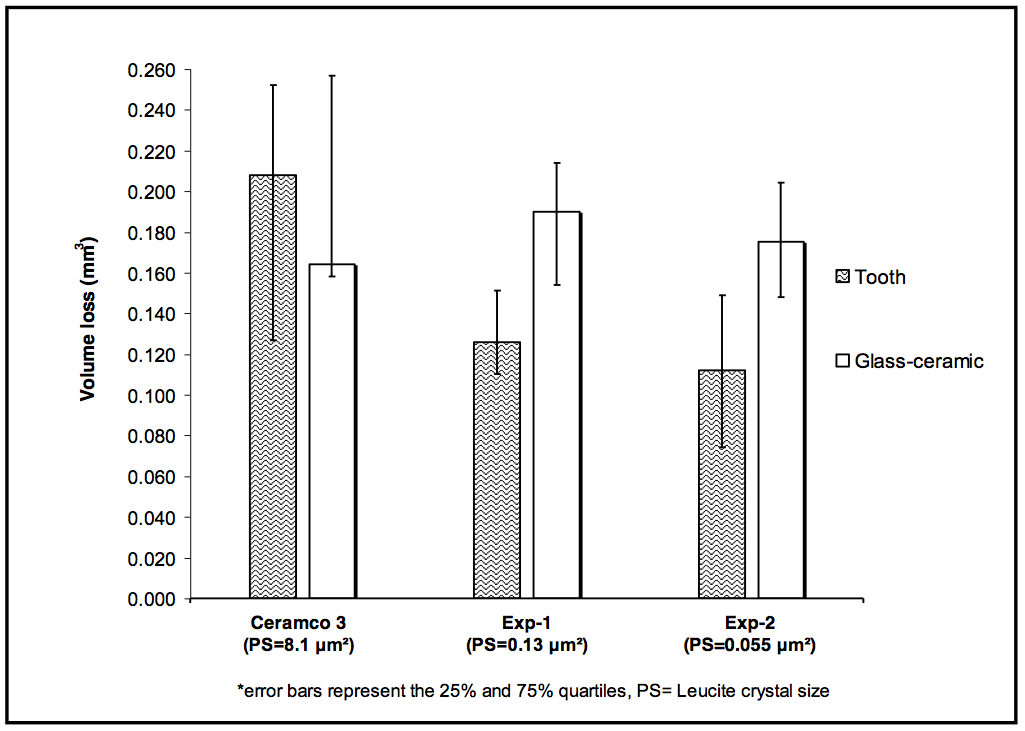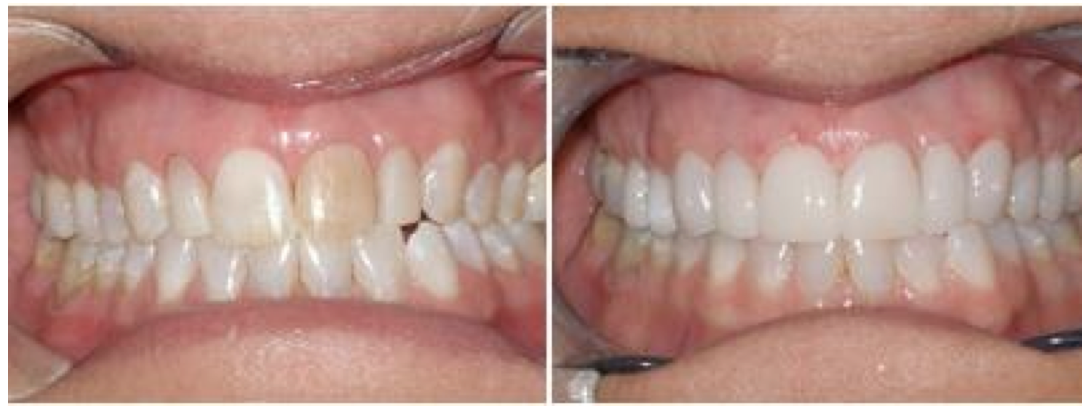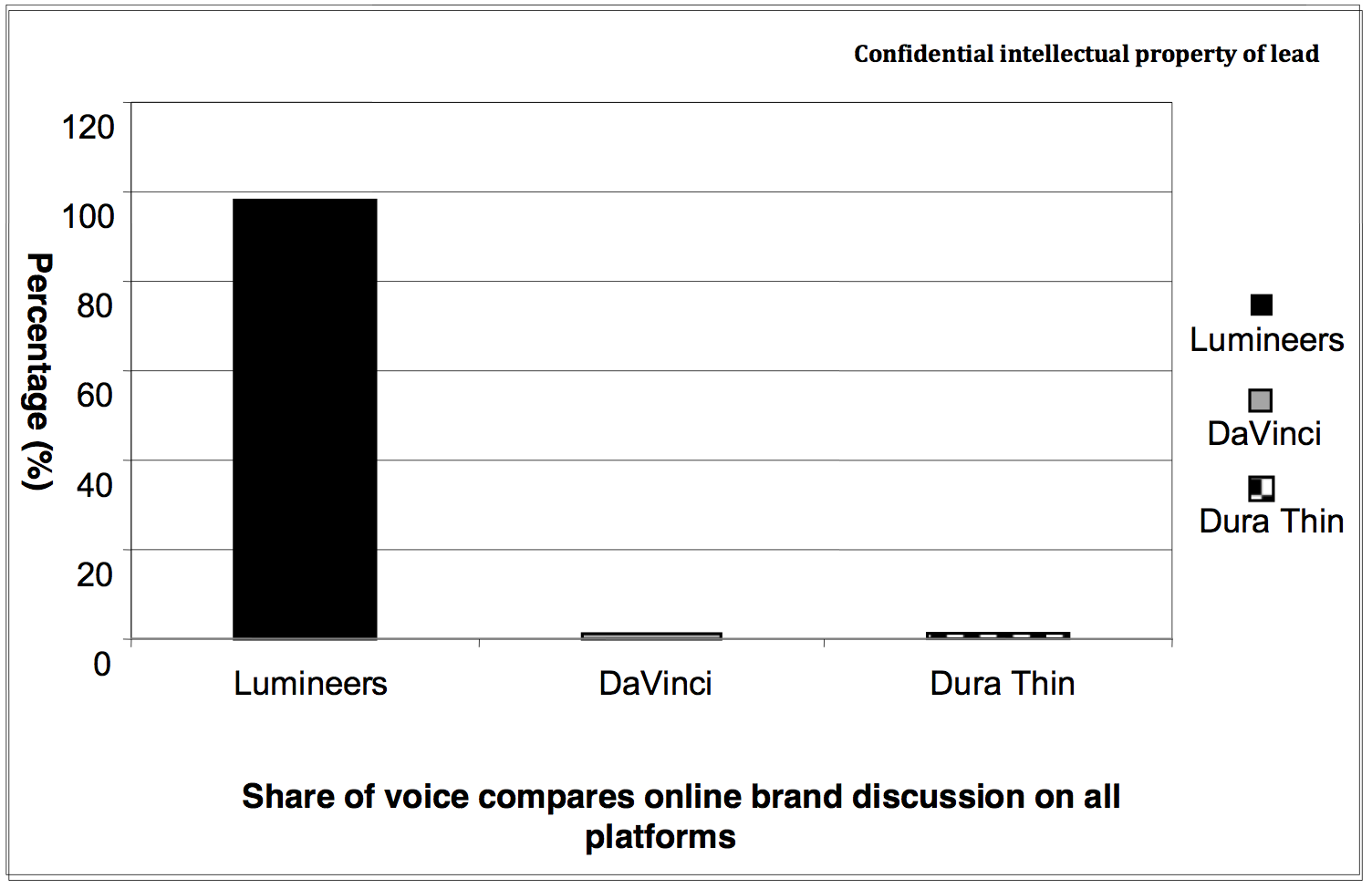Novel high strength, low wear leucite glass-ceramics
Submitting Institution
Queen Mary, University of LondonUnit of Assessment
Allied Health Professions, Dentistry, Nursing and PharmacySummary Impact Type
TechnologicalResearch Subject Area(s)
Engineering: Biomedical Engineering, Materials Engineering
Medical and Health Sciences: Dentistry
Summary of the impact
Novel low-wear, high-strength glass-ceramics were developed at Queen Mary
in 2000-2011 by Dr Cattell's team to prevent facture and wear of dental
ceramic restorations. Over three million restorations have been provided
for patients and sold in 46 countries. The product has won industry awards
for clinical and cosmetic excellence from the Clinical Research Associates
and Dental Advisor, who externally assess products for consumers. The
product uses a 100% pain-free minimally invasive approach, saving as much
as 20% enamel reduction per patient, as tooth preparation and anaesthesia
are not required. We also estimate a substantial reduction in tooth enamel
wear of 43-46% for this nano-scale product compared to commercial
porcelain. It has high patient acceptance and satisfaction, and has
received media coverage worldwide.
Underpinning research
Dr Cattell, Senior Lecturer in Dental Technology, undertook this research
(2000-2011) with his team at Queen Mary to address problems encountered in
clinical dentistry, particularly in general practice, with brittle
fracture of porcelain restorations and their poor survival rates over ten
years (crowns = 52% and veneers = 47%) and substantial costs (£117.5M and
£6.5M respectively). The team also considered problems of tooth wear
against current abrasive porcelains, as 14% of people in the UK suffer
from bruxism (teeth grinding). The objectives were to produce low-wear and
high-strength aesthetic glass-ceramics to resolve these problems and
reduce patient pain.
Fundamental work
Dr Cattell conducted the fundamental work on leucite glass-ceramics
(2000-2004) that led to the Cerinate heat extruded commercial product.
Processing of these leucite glass-ceramics using heat extrusion to produce
dental restorations led to an even distribution of fine crystallites and
increases in tested reliability (m = 9.4, m = Weibull Modulus) and
flexural strength (159.1 MPa) compared with current materials (120.1 MPa,
m = 6.1) [1]. During this work he discovered a process of controlling the
leucite crystal size in a thermally compatible glass [2]. His team
discovered that control of the chemistry and physical properties of the
glass, together with crystallite size, were key to enhancing the
properties of the glass-ceramic. They also demonstrated efficient adhesive
bonding of these materials and further surface strengthening (200.2 MPa)
[3].
Discovery of high-strength / low-wear leucite glass-ceramics
Dr Cattell's team (2005-2011) worked with Professor Hill on the original
glass formulation together with a range of new glasses. These glasses were
designed using Appen factors so properties like refractive index, thermal
expansion and fusion temperature could be predicted before the glasses
were made. Tailoring these properties to that of the leucite crystal phase
allowed the production of transparent and highly aesthetic materials, with
residual strains between the crystal and glass matrix matched to encourage
increases in mechanical properties. Controlled fusion temperature also
allowed the fabrication of dental restorations at temperatures suitable
for manufacturing.
The team also focussed on the fundamental aspects of nucleation and
crystal growth of leucite glass-ceramics and powder processing to control
surface crystallisation and produce fine [4] and, later, nano-scale
leucite glass-ceramics. These studies were critical to reducing the size
of the abrasive leucite crystals that had enormous benefits in terms of
reduced enamel wear, improved aesthetics and increased strength. Leucite
glass-ceramics were produced with significantly higher flexural strength
(>250 MPa, Figure 1) and reliability (m=11.9) when compared to a
European market leader [5]. Research ethics approval was gained to test
the wear of these new materials against human enamel (REC: 06/Q0603/98).
The outcome was significantly lower enamel wear compared with a commercial
market leader [6] (Figure 2).
New technologies
The group also demonstrated these materials could be processed using heat
extrusion and newer CAD-CAM and 3D-printing technologies to produce dental
restorations. This material was adopted as an aesthetic restorative
material for clinical use (Lumineers® 2, Den-Mat Holdings,
USA), and used in the fabrication of over three million dental
restorations. These stronger materials are used in thin section
encouraging minimally invasive adhesive dentistry. The outcomes are less
drilling and pain for patients and prevention of crown fracture and
destructive enamel wear.
 Fig. 1: Flexural strength of the Experimental/
Commercial glass-ceramics
Fig. 1: Flexural strength of the Experimental/
Commercial glass-ceramics
 Fig. 2: Wear of the Experimental/
Commercial glass-ceramics
Fig. 2: Wear of the Experimental/
Commercial glass-ceramics
References to the research
1. Cattell MJ, Chadwick TC, Knowles JC, Clarke RL, Lynch E.
Flexural strength optimization of a fleucite reinforced glass ceramic. Dental
Materials, 2001; 17: 21-33.
2. Cattell MJ, Chadwick TC, Knowles JC, Clarke RL, Samarawickrama
DYD. The nucleation and crystallization of fine grained leucite
glass-ceramics for dental applications. Dental Materials, 2006;
22, 925-933.
3. Cattell MJ, Chadwick TC, Knowles JC, Clarke RL. Development
and testing of glaze materials for application to the fit surface of
dental ceramic restorations. Dental Materials, 2009; 25, 431-441.
4. Chen XI, Chadwick TC, Wilson RM, Hill R and Cattell MJ.
Crystallization of High Strength-Fine-Sized Leucite Glass-Ceramics. Journal
of Dental Research, 2010; 89, 1510-1516.
5. Chen XI, Chadwick TC, Wilson RM, Hill R and Cattell MJ.
Crystallization and flexural strength optimization of fine-grained leucite
glass-ceramics for dentistry. Dental Materials, 2011; 2 7
1153-1161.
6. Theocharopoulos A, Chen X, Hill R and Cattell M.J.
Reduced wear of enamel with novel fine and nano-scale leucite
glass-ceramics. Journal of Dentistry, 2013; 41, 561-568.
Research was supported by grants from: Support for Oral Science
PhD studentship (Barts and the London, 2005-09); Barts and The London
Charity (2007-11); Industry (Den-Mat Corp., USA) (2006-09).
Details of the impact
4a: World distribution and sales
Over three million dental restorations have been manufactured and placed
for patients using these highly successful glass-ceramics, generating
significant industry and general dental practice profits [7]. It is now a
global product sold in 46 countries including: The Americas (USA,
Canada, Brazil, Mexico, Venezuela); Europe (UK, France, Germany,
Italy, Belgium, Spain, Russia, Poland, Greece, Hungary, Estonia, Bulgaria,
Cyprus); Asia Pacific (Australia, Japan, Hong Kong, Taiwan,
Indonesia, Vietnam, Philippines, Korea); and Middle East and Africa:
(Dubai, Kuwait, Kazakhstan, Morocco, Israel, Africa GCC, Turkey). There
has been an improved public understanding of minimally invasive dentistry
as these new materials and techniques have been covered extensively in
newspapers and magazines, including Readers Digest (circulation
>10m) [8], and on the internet and TV, making these the most
patient-requested thin veneers in dentistry.
4b: Industry and academic recognition and clinical trials
During clinical trials this leucite glass-ceramic was clinically rated
`excellent' by the Dental Advisor and by the Clinical Research Associates
(CRA), both of whom are major external assessors who evaluate products for
the dental profession and consumers. The Leucite glass-ceramic (Lumineers
2 ®) was also awarded top cosmetic product by the Dental Advisor (2009)
[9]. The research work behind this material also won the Voco prize for
Dental Biomaterials research at the International Association of Dental
Research meeting in 2010 [10]. Improved methodology for the measurement of
tooth wear using white light profilometry was developed during this work
[11], which has been cited in the literature and is of use in the
scientific community.
4c: Change in clinical practice worldwide
The major impact of this research is that these unique high-strength
glass-ceramics are used in thinner section (as thin as a contact lens)
allowing minimal or "no tooth" drilling and eliminating the associated
pain, discomfort, and local anaesthesia injections (by up to 100%)
required to prepare teeth (www.lumineers.com/h2_lumineers_why)
[12]. This also means 100% reduction in postoperative patient pain, less
tooth destruction (20% less) and fewer or no provisional restorations.
This equates to 25% more profit for dental practices when placing this
system (versus traditional materials). High aesthetics combined with a
pain-free minimally invasive tooth preparation approach [9] has led to
high patient acceptance and satisfaction with this product (Figure 3).
This information has been fed back from numerous dental practices
(>13,000 dentists in the USA use Lumineers) via patient and
practitioner testimonials [13]. These materials can be easily acid etched
and adhesively bonded to tooth structure and this has made them
particularly useful in the treatment of children with microdontia,
tetracycline staining and amelogenesis imperfecta.
4d: Patient and dentist testimonials
A patient said: "The process was amazing — it was almost too
easy! No shots, drilling or pain was associated with getting Lumineers.
I love how natural they look and feel. Who knew getting a new beautiful
smile could be so easy." [13b]. A dentist said: "Tremendous
benefits for all our patients because of the no shots or temporaries. It
produces a tremendous smile with very little or no discomfort to the
patient." [13b].
 Fig. 3: Before and after the use of Lumineers
Fig. 3: Before and after the use of Lumineers
4e: New low-wear materials
Another major impact of this study was to produce fine and nano-scale
leucite glass-ceramics with dramatically reduced enamel wear properties.
Many conventional porcelains/ceramics are destructive to tooth structure
(four times more abrasive than enamel) and this is increased in patients
with bruxism. In the UK 8-10% of the population are affected by tooth
wear. The current materials have the opposite effect and will be kinder to
tooth structure. We estimate the nano-scale materials give a staggering
reduction in tooth enamel wear of 43-46% compared to the commercial
porcelain in our study (6). This is of great benefit to patients to reduce
tooth destruction, pain and the prevention of more complex dental
treatment, such as costly bridges and implants when worn teeth are
difficult to restore. These materials do not have biocompability issues
and are less cytotoxic than current lithium disilicate ceramics, many
metals and composites. There is less or no drilling and its associated
pain for patients, and up to 100% less post-operative pain. The materials
can also prevent future repeat or more complex dental treatment, hence
high satisfaction in both adults and children.
4f: Industry feedback and publications
The Leucite glass-ceramics developed at Queen Mary were translated into
two products by a US-based company (Den-Mat Holdings), with two patents
filed [14, 15], and seven published papers [eg 1-6]. Dr Cattell was
responsible for translating this lab-based research to industry and
setting up the processing technology. This led to a heat extruded leucite
glass-ceramic (Cerinate Pressable) and the Lumineers® 2 glass-ceramic used
in conjunction with new CAD-CAM and 3D-printing technologies [16]. The
versatility of these products and the ease of manufacture made them
desirable to industry and generated significant industry and general
dental practice income (veneers cost $800-2,000 per tooth in US practice).
www.lumineers.com/h2_lumineers_cost
This resulted in hiring of new staff (increased employment in California)
at the US-based dental company and investment in new technology [17]. A
recent company consumer assessment of online conversation related to
branded dental veneers indicated the dominance of Lumineers over two of
their primary competitors (Figure 4).
 Fig. 4: Competitive analysis: Share of voice
Fig. 4: Competitive analysis: Share of voice
Sources to corroborate the impact
- Senior Director Research and Development, Den-Mat Holdings, LLC
- Summary of Lumineers media coverage in US http://lumismilecentral.net/in-the-news/
- Dental Advisor report, 2009. Available from: www.dentaladvisor.com/clinical-evaluations/product-awards/2009-product-awards.shtml#anterior
- Theocharopoulos, A., Chen, X., Hill, R. and Cattell, M.J (2010) Wear
characteristics of an experimental high-strength fine-sized leucite
glass-ceramic, IADR General Session, Barcelona http://iadr.confex.com/iadr/2010barce/preliminaryprogram/abstract_132248.htm
- Theocharopoulos A, Zou L, Hill R, Cattell MJ. Wear quantification of
human enamel and dental glass-ceramics using white light profilometry. Wear,
2010; 269, 930-93.
- Lumineers® Smile Design Studio Catalogue: www.denmed.com/lumineersdds/pliki/smile-design-catalog.pdf
- Patient website testimonials available from: (a)
www.yourlifesmiles.com/before-and-after and (b) http://atlantagentledental.com/news/lumineers-testimonials/
- Ibsen R, Chen XH, Cattell MJ, Riddell JV, Chadwick TC. Control of
Ceramic Microstructure US Patent 2009/0081104 A1 March 26th
2009. www.google.com/patents/US20090081104
- Ibsen R, Chen XH, Cattell MJ, Riddell JV. Strong Glass-Ceramic US
Patent 2010 /0119431A May 13th 2010. www.google.com/patents/US20100119431
- Forward trends: veneers. Dental Products Report [Internet], April
2009, 20-21. www.nxtbook.com/nxtbooks/advanstar/dlp_200904/index.php?startid=20#/21
- Research Scientist, Research and Development, Den-Mat Holdings, LLC.